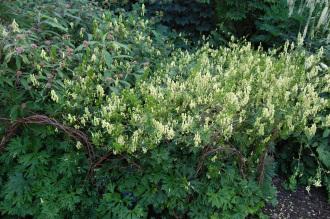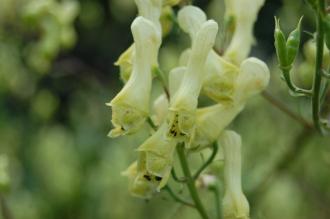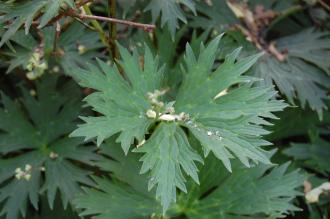
Aconitum lycoctonum subsp. neapolitanum (18/07/2015, Kew Gardens, London)
Position: Partial shade to shade
Flowering period: Summer
Soil: Moist, well drained
Eventual Height: 1.2m
Eventual Spread: 60m
Hardiness: 4a, 4b, 5a, 5b, 6a, 6b, 7a, 7b, 8a, 8b, 9a
Family: Ranunculaceae
Aconitum lycoctonum subsp. neapolitanum is a deciduous, herbaceous perennial with an erect, clump forming habit. Its glossy dark green leaves are rounded, palmate, deeply lobed with up to 7 segments and up to 7cm across. Its pale yellow flowers appear in the shape of hoods, are up to 4cm tall and appear on erect flowering stalks. Its roots are tubers which aids is spread.

Aconitum lycoctonum subsp. neapolitanum Flower (18/07/2015, Kew Gardens, London)
Aconitum lycoctonum subsp. neapolitanum, commonly known as Wolfsbane, Yellow Wolfsbane, Northern Wolfsbane or Yellow Monkshood, is native to the mountains of southern Europe. In its native habitat it grows in damp shady places including deciduous forests. All parts of this plant are extremely toxic.
The etymological root of the binomial name Aconitum is from the ancient Greek name for this plant and is loosely translated as ‘unconquerable poison’. Lycoctonum is derived from the Greek lukos meaning ‘wolf’ and kteinw menaing ‘to kill’.

Aconitum lycoctonum subsp. neapolitanum Leaf (18/07/2015, Kew Gardens, London)
The landscape architect may find Aconitum lycoctonum subsp neapolitanum useful as part of a woodland planting scheme. It is also suitable for use as part of a mixed herbaceous planting scheme. Care should be taken when locating this plant due to its poisonous nature, including ingestion via skin.
Ecologically, Aconitum lycoctonum subsp neapolitanum flowers are attractive to pollinating insects, including bees and butterflies.
Aconitum lycoctonum subsp neapolitanum prefers moist, fertile, well-drained soils. It tolerates most pH of soil. It will not tolerate dry soils.
Aconitum lycoctonum subsp neapolitanum requires little maintenance. To keep a tidy appearance old flowering stems may be removed in spring. Large clumps may be divided in late autumn.

Landscape Architecture

